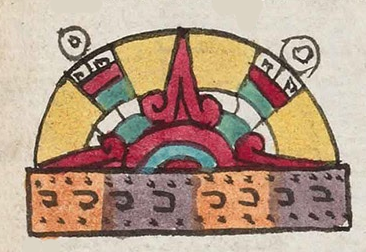Teotlalpan (Mdz51r)
This compound glyph for the place name Teotlalpan has two principal components, divine or sacred force(s) (teotl) and land or agricultural parcel (tlalli). The teotl) glyph is in a half-circle and is painted multiple colors (red, green, yellow, white, and turquoise). The tlalli is a horizontal rectangle with alternating segments of purple and terracotta or orange, with texturing consisting of dots and u-shapes. We look down on the parcel from a bird's eye view.
Stephanie Wood
The -pan locative suffix is either not shown visually, or it is implied by the placement of the symbol for divine force(s) on top of the land, given that -pan means "on." The main components do combine into a word of their own (teotlalli), referring to land of the temples and deities or, according to Alonso de Molina, valley land or unoccupied land that is flat and long, perhaps wilderness.
Stephanie Wood
teotlalpan. puo
Teotlalpan, pueblo
Stephanie Wood
c. 1541, or by 1553 at the latest
Stephanie Wood
divinidad, tierras, parcelas, nombres de lugares

teo(tl), divine or sacred force(s), https://nahuatl.wired-humanities.org/content/teotl
tlal(li), land or agricultural parcel, https://nahuatl.wired-humanities.org/content/tlalli
teotlal(li), sacred lands, https://nahuatl.wired-humanities.org/content/teotlalli
-pan (locative suffix), on, https://nahuatl.wired-humanities.org/content/pan
Codex Mendoza, folio 51 recto, https://digital.bodleian.ox.ac.uk/objects/2fea788e-2aa2-4f08-b6d9-648c00..., image 112 of 118.
The Bodleian Libraries, University of Oxford, hold the original manuscript, the MS. Arch. Selden. A. 1. This image is published here under the UK Creative Commons, “Attribution-NonCommercial-ShareAlike 3.0 License” (CC-BY-NC-SA 3.0).





